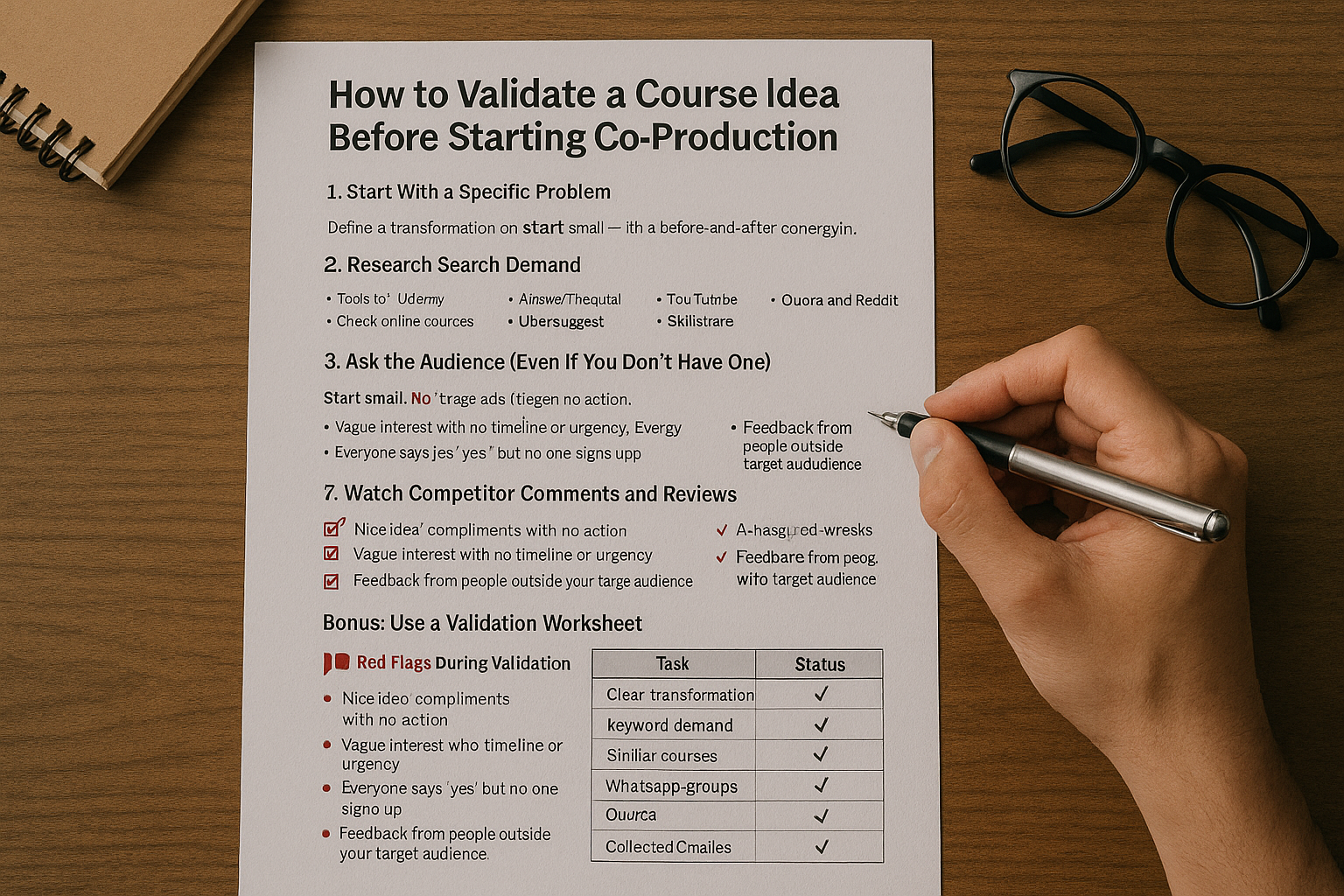Launching a course is exciting — but launching the wrong course can waste time, money, and energy. That’s why validating your course idea before production is one of the smartest steps a co-producer can take.
In this article, you’ll learn simple, effective ways to test demand, gather feedback, and ensure the topic you’re co-producing actually solves a problem people are willing to pay to solve.
What Does “Validating a Course Idea” Mean?
Validation means proving that your course idea has real demand before you spend weeks (or months) building it.
Instead of assuming what people want, you find out by:
- Asking questions
- Observing behavior
- Testing responses
- Measuring engagement
Think of it as market research on a practical level — it saves you from guessing.
Why Most Courses Fail
Many digital courses fail not because the content is bad — but because there’s no real audience craving that solution.
Common reasons include:
- Course solves a problem no one is actively trying to fix
- Too broad or unclear audience targeting
- Weak positioning that doesn’t stand out
- Wrong pricing for the market
- Lack of emotional connection or urgency
Validation helps prevent all of this by proving there’s an audience before you build the full product.
Step 1: Start With a Specific Problem
A great course doesn’t try to teach everything. It solves one painful, specific problem.
Instead of:
❌ “Learn everything about business”
Try:
✅ “How to create your first online product in 14 days”
Ask the expert you’re co-producing with:
- What questions do people ask you the most?
- What frustrates your audience right now?
- What transformation have you helped others achieve before?
A defined before-and-after transformation is your foundation.
Step 2: Research Search Demand
Use free tools to find out what people are already searching for online.
Tools to Use:
- Google Search – autocomplete suggestions and related searches
- AnswerThePublic – visual map of common questions
- Ubersuggest – search volume and keyword difficulty
- YouTube – see what tutorials are trending
- Quora and Reddit – discover pain points in real conversations
✅ If people are searching for it, there’s potential demand.
Step 3: Check Online Course Platforms
See if other courses on your topic already exist — this is a good sign, not a bad one.
Search on:
- Udemy
- Hotmart
- Domestika
- Coursera
- Skillshare
Look at:
- Course titles and subtitles
- Number of reviews
- Price ranges
- Topics covered
If multiple courses exist with good engagement, your idea is likely valid — but you’ll need to differentiate your angle.
Step 4: Ask the Audience (Even If You Don’t Have One)
If your expert partner already has an audience — use it.
Post polls, questions, and open surveys via:
- Instagram Stories
- Email list
- WhatsApp groups
- Facebook or LinkedIn posts
- Telegram channels
Ask things like:
- “If I created a course on X, would you be interested?”
- “What’s your biggest struggle with Y?”
- “Which of these topics excites you the most?” (use polls)
If you get no responses, consider reframing the offer or topic.
Step 5: Pre-Sell or Pre-Validate with a Waiting List
This is one of the strongest validation methods: get people to commit before the product exists.
Ways to Pre-Validate:
- Create a waiting list landing page
- Offer a discount for early access
- Sell a “beta version” with limited spots
- Host a free masterclass and pitch the course at the end
If people sign up, it’s working. If no one signs up, you just saved weeks of wasted work.
Step 6: Watch Competitor Comments and Reviews
Go through the reviews of similar courses or social media posts from competitors. Pay attention to:
- What students liked
- What they were missing
- What they wanted more of
This gives you ideas for angles, bonuses, and messaging that hit real desires.
✅ Use this to position your course as a better, more specific solution.
Step 7: Define a Minimum Viable Course (MVC)
If your idea gets validated, start small.
A minimum viable course is a lightweight version of your full idea — a mini course, workshop, or even live class that delivers the transformation quickly.
Benefits:
- Lower production cost
- Faster to launch
- Real feedback in real time
- Easy to improve later
Don’t wait to be “ready” — validate, build something simple, and launch to learn.
Red Flags During Validation
Watch out for:
🚫 “Nice idea” compliments with no action
🚫 Vague interest with no timeline or urgency
🚫 Everyone says “yes” but no one signs up
🚫 Feedback from people outside your target audience
Only take action on feedback from people who would actually pay.
Bonus: Use a Validation Worksheet
Create a simple validation checklist like this:
| Task | Status |
| Clear transformation defined | ✅ / ❌ |
| Keyword demand researched | ✅ / ❌ |
| Similar courses with engagement | ✅ / ❌ |
| At least 10 audience survey responses | ✅ / ❌ |
| Pre-launch landing page tested | ✅ / ❌ |
| Collected emails or early interest | ✅ / ❌ |
✅ When most boxes are checked, move to production.
Final Thoughts: Don’t Build Blind
Course production takes time, energy, and collaboration. Don’t guess — validate.
A validated course idea is easier to sell, easier to improve, and more fun to build because you know it matters.
As a co-producer, you add huge value by testing and refining the idea before launch. This makes you a strategic partner, not just an executor.
Start small, ask the market, and build what people are already looking for — with clarity, confidence, and care.

